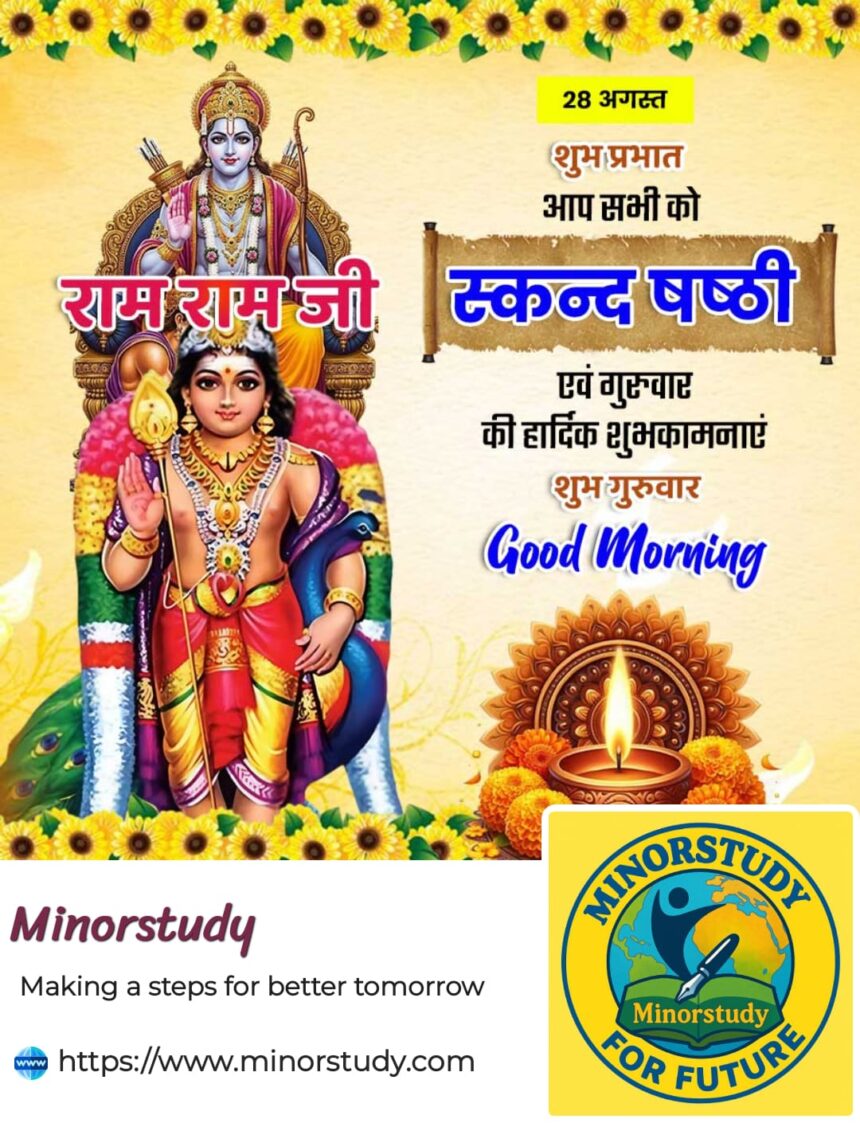Introduction
Among the many Hindu festivals that celebrate divine triumphs, Skanda Shashti holds a special place. Dedicated to Lord Skanda (also known as Kartikeya, Murugan, or Subramanya), this festival commemorates the victory of good over evil, symbolizing courage, devotion, and righteousness.
- Introduction
- History of Skanda Shashti
- Timeline of Skanda Shashti
- Interesting Facts About Skanda Shashti
- Significance of Skanda Shashti
- 1. Victory of Good Over Evil
- 2. Spiritual Discipline
- 3. Cultural Unity
- 4. Devotion to Lord Murugan
- 5. Symbol of Courage
- Observance and Rituals of Skanda Shashti
- Important Points About Skanda Shashti
- Daily Life Impacts of Skanda Shashti Teachings
- Importance in Society
- Wishing Messages for Skanda Shashti
- FAQs on Skanda Shashti
- Conclusion: Why Skanda Shashti Still Matters Today
Celebrated mainly in Tamil Nadu, Kerala, Karnataka, Andhra Pradesh, and Sri Lanka, Skanda Shashti unites millions of devotees in their love and reverence for Lord Murugan. With its spiritual stories, fasting rituals, devotional songs, and dramatic enactments of divine battles, the festival is not just about worship—it is about strengthening faith, instilling discipline, and spreading positivity.
This article explores the complete history, significance, timeline, observances, FAQs, wishing messages, and life impacts of Skanda Shashti in a human-friendly way.
History of Skanda Shashti
The roots of Skanda Shashti lie in the mythological tale of Lord Murugan’s birth and his victory over the demon Surapadman.
According to the Skanda Purana, the demon Tarakasura and his brothers Surapadman and Simhamukhan terrorized the gods. Unable to defeat them, the devas sought the help of Lord Shiva.
From the sparks of Lord Shiva’s third eye, six divine sparks emerged, which were carried by Agni (fire god) and Ganga to the sacred lake Saravana Poigai.
These sparks transformed into six infants, who were nurtured by the Krittika stars (Pleiades).
Goddess Parvati embraced the six children into one form with six faces—thus was born Lord Skanda (Murugan), the god of war.
Skanda was chosen as the commander of the divine army, and on the sixth day (Shashti), he defeated Surapadman and restored peace in the heavens.
This triumph of good over evil is celebrated every year as Skanda Shashti.
Timeline of Skanda Shashti
Mythological Era – Lord Murugan slays Surapadman and establishes dharma.
Ancient Tamil Sangam Age – Murugan worship gains prominence; temples like Palani, Tiruchendur, and Swamimalai become major centers.
Medieval Period – Bhakti saints like Arunagirinathar spread Murugan’s glory through hymns (Thiruppugazh).
Colonial Era – Despite cultural suppression, Skanda Shashti observances thrived in Tamil Nadu and Sri Lanka.
Modern Era – Skanda Shashti is celebrated worldwide by Tamil communities, with digital participation, temple live-streams, and cultural programs.
Interesting Facts About Skanda Shashti
Skanda Shashti lasts for six days, with the sixth day being the most significant.
The Soorasamharam (enactment of the battle between Murugan and Surapadman) is the festival highlight.
Devotees observe fasting and penance, similar to Navratri’s discipline.
Murugan Kavadi Attam (devotional dance carrying offerings) is performed in many places.
Tiruchendur Temple in Tamil Nadu is world-famous for grand Soorasamharam celebrations.
Lord Murugan is known as Kartikeya in North India, Subramanya in Karnataka, and Skanda in scriptures.
The six most sacred Murugan temples, called Arupadai Veedu, are central to Skanda Shashti observance.
Significance of Skanda Shashti
1. Victory of Good Over Evil
It symbolizes the eternal truth that righteousness always triumphs over arrogance and negativity.
2. Spiritual Discipline
The fasting and prayers during Skanda Shashti encourage self-control, mental purity, and devotion.
3. Cultural Unity
The festival unites millions of Tamil Hindus across the world, fostering a strong cultural bond.
4. Devotion to Lord Murugan
Murugan is seen as a protector and guide, especially for youth seeking strength and wisdom.
5. Symbol of Courage
The battle of Skanda inspires devotees to face life’s struggles with fearlessness and determination.
Observance and Rituals of Skanda Shashti
Fasting: Devotees fast partially or fully for six days, consuming only fruits and milk.
Temple Visits: Major Murugan temples like Palani, Tiruchendur, Swamimalai, Thirupparankundram, Tiruttani, and Pazhamudircholai host grand festivities.
Chanting Hymns: Devotees recite Kanda Shasti Kavasam, a powerful hymn invoking Murugan’s protection.
Soorasamharam: A dramatic enactment of Lord Murugan’s victory over Surapadman, performed in temple grounds.
Devotional Music and Dance: Performances of bhajans, kavadi attam, and classical dance honor Murugan.
Important Points About Skanda Shashti
Celebrated in the Tamil month of Aippasi (October–November).
The sixth day (Shashti) marks Soorasamharam, the defeat of evil.
Murugan is worshipped as the god of war, wisdom, and protection.
The fast is believed to cleanse karma and bring blessings.
It is one of the most spiritually intense Tamil Hindu festivals.
Daily Life Impacts of Skanda Shashti Teachings
Encourages us to fight our inner demons of anger, ego, and greed.
Teaches the importance of discipline and willpower through fasting.
Inspires youth and professionals to embrace courage in challenges.
Promotes unity in diversity, as Murugan is worshipped across regions with different names.
Brings peace of mind, devotion, and moral strength to devotees.
Importance in Society
Preserves the Tamil spiritual and cultural heritage.
Strengthens community bonds through temple festivals and collective fasting.
Promotes values of righteousness, discipline, and courage in daily life.
Encourages art, music, literature, and drama through devotional performances.
Inspires the younger generation to stay rooted in tradition and moral strength.
Wishing Messages for Skanda Shashti
🌸 “May Lord Murugan bless you with courage, wisdom, and prosperity this Skanda Shashti!”
🌸 “On Skanda Shashti, let us celebrate the triumph of good over evil and walk the path of righteousness.”
🌸 “Happy Skanda Shashti! May your life be filled with strength, positivity, and divine grace.”
FAQs on Skanda Shashti
Q1. What is Skanda Shashti?
A1. It is a Hindu festival dedicated to Lord Murugan, celebrating his victory over the demon Surapadman.
Q2. When is Skanda Shashti celebrated?
A2. It is observed in the Tamil month of Aippasi (October–November) for six days.
Q3. What is the significance of fasting during Skanda Shashti?
A3. Fasting purifies the mind and body, builds discipline, and strengthens devotion.
Q4. Where is Skanda Shashti celebrated most grandly?
A4. Tiruchendur Murugan Temple in Tamil Nadu is famous for its Soorasamharam celebrations.
Q5. What is the spiritual meaning of Skanda Shashti?
A5. It symbolizes the victory of good over evil and the courage to face life’s challenges.
Conclusion: Why Skanda Shashti Still Matters Today
Skanda Shashti is not just a festival—it is a living philosophy. It teaches us to battle our inner weaknesses with courage, faith, and discipline, just as Lord Murugan defeated Surapadman.
In today’s fast-paced, stressful world, the principles of Skanda Shashti remain deeply relevant:
Stay strong against negativity.
Be disciplined in thought and action.
Cultivate devotion and humility.
Protect righteousness in society.
By observing Skanda Shashti, we not only honor Lord Murugan but also embrace values that bring balance, positivity, and strength into our daily lives.
Truly, this festival is a beacon of courage and devotion that continues to inspire millions.









Hi, Neat post. There’s a problem along with your website in web explorer, might test this… IE nonetheless is the marketplace leader and a big part of other people will leave out your excellent writing due to this problem.